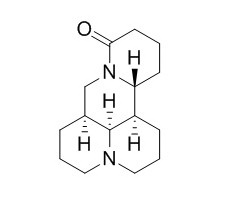Natural Products
Matrine
| Catalog No. | CFN98835 |  |
| CAS No. | 519-02-8 | |
| Molecular Weight: | 248.4 | |
| Molecular Formula | C15H24N2O | |
| DBs | [PubChem]:274951670 [ChEMBL]:6700 [PCIDB]:2227 |
Standard InChI:
InChI=1S/C15H24N2O/c18-14-7-1-6-13-12-5-3-9-16-8-2-4-11(15(12)16)10-17(13)14/h11-13,15H,1-10H2/t11-,12+,13+,15-/m0/s1
Biological Activity
Matrine, an alkaloid purified from the chinese herb Sophora flavescens Ait, is well known to possess activities including anti-inflammation, anti-fibrotic and anticancer, it could inhibit cell proliferation and induce apoptosis of SGC-7901 cells in vitro by up-regulating Fas/FasL expression and activating caspase-3 enzyme.[1]
Matrine upregulates the cell cycle protein E2F-1 and triggers apoptosis via the mitochondrial pathway in K562 cells, it is a potential anti-drug.[2]
Matrine suppresses PMA-induced MMP-1 expression through inhibition of the AP-1 signaling pathway and also may be beneficial for treatment of some inflammatory skin disorders.[3]
Matrine can induce gastric cancer MKN45 cells apoptosis via increasing pro-apoptotic molecules of Bcl-2 family, also inhibits matrix metalloproteinase-9 expression and invasion of human hepatocellular carcinoma cells.[4,5]
Matrine can improve 2,4,6-trinitrobenzene sulfonic acid (TNBS)-induced colitis in mice and the therapeutic mechanism might be related to the reduction of up-regulated colonic TNF-α production caused by TNBS.[6]
Matrine seems to be a novel autophagy inhibitor that can modulate the maturation process of lysosomal proteases.[7]
Matrine can reduce the mortality of acetaminophen overdosed mice more effectively, attenuate acetaminophen-induced hepatotoxicity, and reduces the number and area of γ-GT positive foci, thus protecting liver function and preventing HCC from occurring; it
also has a protective effect on immunosuppression, a strong non-specific anti-inflammatory effect, and an effect of reducing the incidence of sodium and water retention.[8]
Product
References
[1] Dai Z J, Gao J, Ji Z Z, et al.J Ethnopharmacol 2009, 123(1):91-6.
[2] Hua J, Hou C H, Zhang S B, et al. Eur J Pharmacol, 2007, 559(2-3):98-108.
[3] Eunsun Jung †, Jongsung Lee †, Huh S, et al.Biofactors, 2008, 33(2):121–8.
[4] Luo C, Zhu Y, Jiang T, et al. Toxicol, 2007, 229(3):245-52.
[5] Yu H B, Zhang H F, Li D Y, et al. J Asian Nat Prod Res, 2011, 13(3):242-50.
[6] Hong C, Bing X, Lin Z, et al. Pharmacol Res, 2006, 53(3):202-8.
[7] Wang Z, Zhang J, Wang Y, et al. Carcinogenesis, 2012, 34(1):128-38.
[8] Wan X Y, Luo M, Li X D, et al. Chem-Biol Interact, 2009, 181(1):15-9.
[9] Jiang Y L, Zhang S Y. Lishizhen Medicine & Materia Medica Research, 2006, 17(11):2204-5.
Product Use Citation





